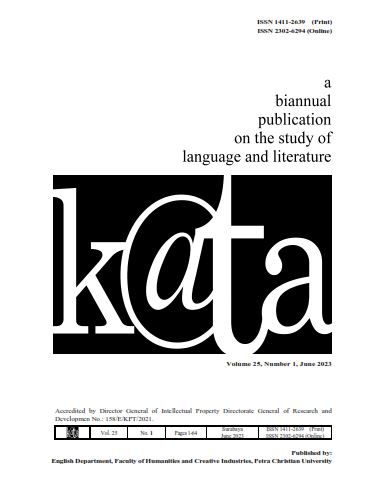Pejorative Words Indicating Indonesian Hate Speech
Abstract
The study aims to identify the pejorative words in @detiknews’ comments and hate speech targets. This study was qualitative research, specifically descriptive content analysis. The researchers took the data from Indonesian comments in eighteen news of @detiknews’ Instagram account. The researchers used MAXQDA to show the results of the coding process. The study has found seven categories of Thurlow: social personality, uncategorized, top-5, racist, homophobic, phallocentric, and physicality. In this study, pejorative words were in the standard and non-standard Indonesian, local languages (Javanese, Betawi), vulgar slang, and animal metaphors. The study has classified pejorative words (Thurlow, 2001) as directed or generalized hate speech (Elsherief et al., 2018). The findings show that directed speech was a personal matter. To sum up, pejorative words indicating hate speech in Indonesia are not randomly used; it intends to show the users’ disagreement toward the publisher or another user’s comment: it is addressed explicitly to either directed or generalized targets.
Downloads
References
Allan, K. (2016). Pragmatics in language change and lexical creativity. SpringerPlus, 5(342), 1–24. https://doi.org/10.1016/j.geomphys.2007.08.010
Carlson, C. R. (2020). Hate Speech as a Structural Phenomenon. First Amendment Studies, 00(00), 1–8. https://doi.org/10.1080/21689725.2020.1837649
Corredor, C. (2014). Pejoratives and social interaction. Issues in Philosophy of Language and Linguistics (Łódź Studies in English and General Linguistics 2), (January 2014), 39–55. Retrieved from https://wydawnictwo.uni.lodz.pl/produkt/issues-in-philosophy-of-language-and-linguistics/
Đorđević, J. P. (2020). The sociocognitive dimension of hate speech in readers’ comments on Serbian news websites. Discourse, Context and Media, 33. https://doi.org/10.1016/j.dcm.2019.100366
ElSherief, M., Kulkarni, V., Nguyen, D., Wang, W. Y., & Belding, E. (2018). Hate lingo: A target-based linguistic analysis of hate speech in social media. 12th International AAAI Conference on Web and Social Media, ICWSM 2018, (ICWSM), 42–51.
Febriyani, M., DM, S., & Husin, B. R. (2018). Analisa Faktor Penyebab Pelaku Melakukan Ujaran Kebencian (hate speech) dalam Media Sosial. Poenale: Jurnal Bagian Hukum Pidana, 6(3). Retrieved from https://jurnal.fh.unila.ac.id/index.php/pidana/article/view/1285/1122
Gelber, K., & McNamara, L. (2016). Evidencing the harms of hate speech. Social Identities, 22(3), 324–341. https://doi.org/10.1080/13504630.2015.1128810
Ghaffari, S. (2020). Discourses of celebrities on Instagram: digital femininity, self-representation and hate speech. Critical Discourse Studies, 0(0), 1–18. https://doi.org/10.1080/17405904.2020.1839923
Hom, C. (2012). A puzzle about pejoratives. Philosophical Studies, 159(3), 383–405. https://doi.org/10.1007/s11098-011-9749-7
Irawan, I. (2018). Hate Speech di Indonesia. Mawa’Izh: Jurnal Dakwah Dan Pengembangan Sosial Kemanusiaan, 9(1), 1–17. https://doi.org/10.32923/maw.v9i1.712
Kusumasari, D., & Arifianto, S. (2019). Makna Teks Ujaran Kebencian Pada Media Sosial | Kusumasari | Jurnal Komunikasi, 12(9), 1–15. Retrieved from https://journal.untar.ac.id/index.php/komunikasi/article/view/4045/4661
Leavy, P. (2017). Research Design: Quantitative, Qualitative,Mixed Methods, Arts-Based, and Community-Based Participatory Research Approaches. New York: The Guilford Press.
Lingiardi, V., Carone, N., Semeraro, G., Musto, C., D’Amico, M., & Brena, S. (2020). Mapping Twitter hate speech towards social and sexual minorities: a lexicon-based approach to semantic content analysis. Behaviour and Information Technology, 39(7), 711–721. https://doi.org/10.1080/0144929X.2019.1607903
Lu, D. (2019, August 17). Google’s hate speech AI may be racially biased. New Scientist, p. 7. https://doi.org/10.1016/s0262-4079(19)31505-2
Martin, N. (2018, November 30). How Social Media Has Changed How We Consume News. Forbes Magazine. Retrieved from https://www.forbes.com/sites/nicolemartin1/2018/11/30/how-social-media-has-changed-how-we-consume-news/#6dd47233c3ca
Mossie, Z., & Wang, J. H. (2019). Vulnerable community identification using hate speech detection on social media. Information Processing and Management, 57(3). https://doi.org/10.1016/j.ipm.2019.102087
NapoleonCat. (n.d.). Instagram Users in Indonesia - January 2020.”. Retrieved from https://napoleoncat.com/stats/instagram-users-in-indonesia/2020/01
Neuendorf, K. A. (2002). The Content Analysis Guidebook. London: Sage Publication.
Ningrum, D. J., Suryadi, S., & Chandra Wardhana, D. E. (2018). Kajian Ujaran Kebencian Di Media Sosial. Jurnal Ilmiah KORPUS, 2(3), 241–252. https://doi.org/10.33369/jik.v2i3.6779
Rangkuti, R., Pratama, A., & Zulfan, Z. (2019). Hate Speech Acts: a Case in Batu Bara. Language Literacy: Journal of Linguistics, Literature, and Language Teaching, 3(2), 225–233. https://doi.org/10.30743/ll.v3i1.1998
Reichelmann, A., Hawdon, J., Costello, M., Ryan, J., Blaya, C., Llorent, V., … Zych, I. (2020). Hate Knows No Boundaries: Online Hate in Six Nations. Deviant Behavior, 42(9), 1100–1111. https://doi.org/https://doi.org/10.1080/01639625.2020.1722337
Sigurbergsson, G. I., & Derczynski, L. (2019). Offensive Language and Hate Speech Detection for Danish, 1–13. Retrieved from http://arxiv.org/abs/1908.04531
Sirulhaq, A. (2018). Questioning “ The Great Indonesian Dictionary ” (KBBI). Advances in Social Science, Education and Humanities Research (ASSEHR), 228, 162–165.
Thurlow, C. (2001). Naming the “outsider within”: Homophobic pejoratives and the verbal abuse of lesbian, gay and bisexual high-school pupils. Journal of Adolescence, 24(1), 25–38. https://doi.org/10.1006/jado.2000.0371
Vedeler, J. S., Olsen, T., & Eriksen, J. (2019). Hate speech harms: a social justice discussion of disabled Norwegians’ experiences. Disability and Society, 34(3), 368–383. https://doi.org/10.1080/09687599.2018.1515723
Winiasih, T. (2010). Pisuhan dalam “Basa Suroboyoan” Kajian Sosiolinguistik. Universitas Sebelas Maret. Retrieved from http://repositori.kemdikbud.go.id/436/1/132140608201011591.pdf

This work is licensed under a Creative Commons Attribution 4.0 International License.
This work is licensed under a Creative Commons Attribution License


















